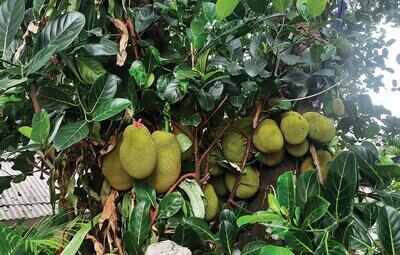Trending Topics
A prickly start to jackfruit’s commercial exploitation

Not too long ago, the humble fruit was often seen rotting on trees, and if removed, was often handed out cheap or free
Panaji: When the jackfruit first hit the market this season, a medium-sized fruit fetched a princely Rs 700.
For those who have grown up in Goa and around jackfruits, the price would be puzzling. Not too long ago, the humble fruit was often seen rotting on trees, and if removed, was often handed out cheap or free.
Fast forward a few years, and the jackfruit is now a “miracle food” and “future superfood”. But although the potential of the prickly fruit is now being recognised, its commercial utilisation remains low.
“Once viewed with inhibition, it has received widespread acceptance as a versatile fruit with many uses due to recent advancements in food technology, and increased media attention,” said MJ Gupta, senior scientist, ICAR-CCARI, Old Goa.
The bulbous fruit also holds potential as a meat substitute. “The surge in demand will surely happen, given its utility as an ingredient in vegan meat substitutes and healthy snack options, thanks to efforts of technologists, media, and startups,” Gupta said.
Even at peak jackfruit season, consumers pay premium prices for the fruit. A small-sized kapo (a preferred local variety) goes for Rs 200-300 a fruit. “Jackfruit prices have more than doubled due to various reasons, one of them perhaps being low availability in Goa,” said horticulturist Miguel Braganza.
In addition to its now well-known health benefits, the jackfruit has even more consumptive uses at various stages than the mango, which is tapped as a pickle, sweet, and a table delicacy. Much like the ubiquitous coconut tree, every part of the jackfruit tree from its leaves to its wood has its uses.
“The jackfruit consumability and potential at various stages — from its raw form when it can be pickled, to the ripe form when it can be used as fresh fruit, or its pulp for processing — is vast,” said A R Desai, former fruit scientist, ICAR-CCARI, Old Goa.
The fruit can be turned into more than 100 dishes. “As a fruit, having a few carpels (meat) as a snack is like a heavy meal. From raw ones, one can make vegetables, bhajias, papad, chips, and pickles. Half-ripe, should be fully matured for biryani and other dishes (as vegan ‘meat’), and while ripe, it can make a variety of sweets,” said Sunetra Talaulikar, former subject matter specialist, ICAR’s Krishi Vigyan Kendra.
However, harvesting it is still a major obstacle. Pluckers are few and the costs and workload high. “Harvesting is a challenge. Not all fruits mature at the same time. A plucker has to be called several times,” said Pandurang Patil, a progressive farmer.
Patil himself has devised a technique to cull fruits from lower levels without damaging them.
However, this wonder fruit’s commercial exploitation is yet to take off. The Union government had notified jackfruit as a crop for North Goa under one district, one product (ODOP). ICAR, Old Goa, and the state agriculture department have initiated several training modules to encourage entrepreneurs to avail schemes, including the PM formalisation of micro-fund processing enterprises (PMFME) programme.
The Goa state biodiversity board (GSBB) has set up, on pilot basis, a multiprocessing centre at Pale-Kothambi and then replicated the model. “The growth is slow but steady. Many inspired by our initiatives are preparing items, thus reducing jackfruit wastage,” said its member secretary, Pradeep Sarmokadam.
For those who have grown up in Goa and around jackfruits, the price would be puzzling. Not too long ago, the humble fruit was often seen rotting on trees, and if removed, was often handed out cheap or free.
Fast forward a few years, and the jackfruit is now a “miracle food” and “future superfood”. But although the potential of the prickly fruit is now being recognised, its commercial utilisation remains low.
“Once viewed with inhibition, it has received widespread acceptance as a versatile fruit with many uses due to recent advancements in food technology, and increased media attention,” said MJ Gupta, senior scientist, ICAR-CCARI, Old Goa.
The bulbous fruit also holds potential as a meat substitute. “The surge in demand will surely happen, given its utility as an ingredient in vegan meat substitutes and healthy snack options, thanks to efforts of technologists, media, and startups,” Gupta said.
Even at peak jackfruit season, consumers pay premium prices for the fruit. A small-sized kapo (a preferred local variety) goes for Rs 200-300 a fruit. “Jackfruit prices have more than doubled due to various reasons, one of them perhaps being low availability in Goa,” said horticulturist Miguel Braganza.
In addition to its now well-known health benefits, the jackfruit has even more consumptive uses at various stages than the mango, which is tapped as a pickle, sweet, and a table delicacy. Much like the ubiquitous coconut tree, every part of the jackfruit tree from its leaves to its wood has its uses.
“The jackfruit consumability and potential at various stages — from its raw form when it can be pickled, to the ripe form when it can be used as fresh fruit, or its pulp for processing — is vast,” said A R Desai, former fruit scientist, ICAR-CCARI, Old Goa.
The fruit can be turned into more than 100 dishes. “As a fruit, having a few carpels (meat) as a snack is like a heavy meal. From raw ones, one can make vegetables, bhajias, papad, chips, and pickles. Half-ripe, should be fully matured for biryani and other dishes (as vegan ‘meat’), and while ripe, it can make a variety of sweets,” said Sunetra Talaulikar, former subject matter specialist, ICAR’s Krishi Vigyan Kendra.
However, harvesting it is still a major obstacle. Pluckers are few and the costs and workload high. “Harvesting is a challenge. Not all fruits mature at the same time. A plucker has to be called several times,” said Pandurang Patil, a progressive farmer.
Patil himself has devised a technique to cull fruits from lower levels without damaging them.
However, this wonder fruit’s commercial exploitation is yet to take off. The Union government had notified jackfruit as a crop for North Goa under one district, one product (ODOP). ICAR, Old Goa, and the state agriculture department have initiated several training modules to encourage entrepreneurs to avail schemes, including the PM formalisation of micro-fund processing enterprises (PMFME) programme.
The Goa state biodiversity board (GSBB) has set up, on pilot basis, a multiprocessing centre at Pale-Kothambi and then replicated the model. “The growth is slow but steady. Many inspired by our initiatives are preparing items, thus reducing jackfruit wastage,” said its member secretary, Pradeep Sarmokadam.

About the Author
Paul FernandesPaul Fernandes, assistant editor (environment) at The Times of India, Goa, has more than two decades of experience behind him. He writes on social, environmental, heritage, archaeological and other issues. His hobbies are music, trekking, adventure and sports, especially football.
Start a Conversation
FOLLOW US ON SOCIAL MEDIA
FacebookTwitterInstagramKOO APPYOUTUBE







